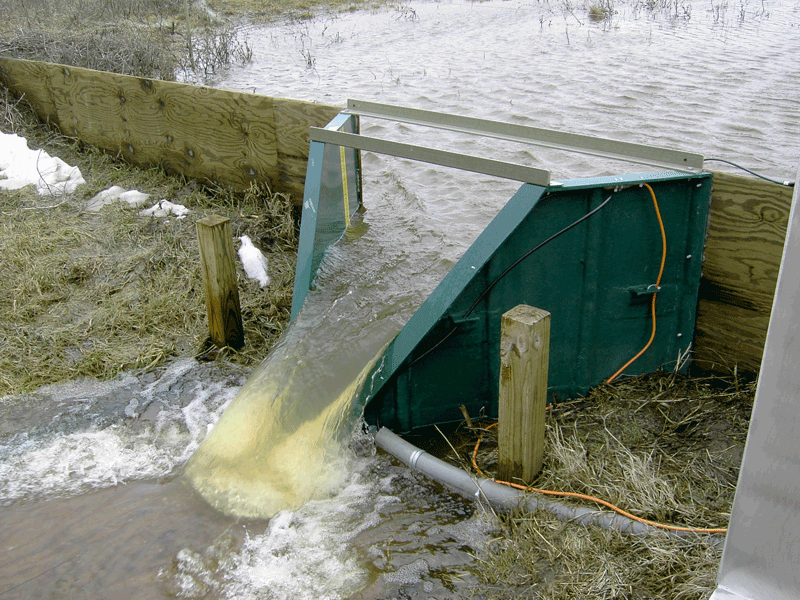Partnering for the environment
DISCOVERY FARMS’ COLLABORATIVE RESEARCH MODEL
PROTECTING THE FUTURE of both the environment and production agriculture is a challenge proudly accepted by the Wisconsin agricultural community. By strategically working together, farmers and researchers built a program to position themselves as key influencers of environmental legislation. Now, they have completed numerous successful projects and are growing their model.
PHOTO: WINTERFLOW FROM A STREAM UNDER OBSERVATION.

Known as the Discovery Farms program, the initiative is led jointly by the University of Wisconsin – Madison and the University of Wisconsin – Extension. It is mandated to lead environmental research on a diverse group of working farms across the state and improve education by communicating findings.
“With respect to the United States, the program is a new approach to agricultural research where all aspects emphasize farmer input and direction,” says program Co-director Eric Cooley.
UNIQUE PROGRAM
Modeled after the farm-based research programs prominent in European countries, Cooley’s program involves studying management practices and the effects of environmental regulations on private farm operations.
“While traditionally research has been conducted through plot trials at small research stations, we have found that a lot of the trials do not scale up well to the conservation challenges that real farms face,” says Cooley.
The program is led by a steering committee of farmers who act as representatives of state commodity groups. The committee provides Cooley’s staff of research specialists with direction as to what type of research the industry needs, what the project focus should be and where the studies should be conducted.
“Being farmer-led has proven to be so effective,” explains Cooley. “Conservation is not one size fits all so we work with the committee to target farms that are representative of different farm types and landscape regions that are found across Wisconsin.”
FARMER-LED INITIATIVES
The overall focus of the Discovery Farms program is water quality. “We do a lot of work around quality monitoring because we really want to better understand the quantity and quality of water that is coming off of agricultural land,” says Cooley.
Established in 2001, the first nine years of the program were spent monitoring core farms, or long-term study locations to collect baseline edge-of-field water quality data. In 2010, the program’s focus shifted to add stream monitoring across two watersheds.
“To ultimately improve water quality in streams, there is a lot to learn about how quality is impacted and how the edge-of-field data correlates with stream delivery,” says Cooley.
IMPACTING POLICY
With this strong background of data and water quality expertise, the UW Discovery Farms program gained momentum and became a stronger voice on environmental regulation issues.
“Wisconsin is a highly regulated state and farmers were first interested in the program because they want environmental regulations to be based on sound science,” says Cooley.
The program is now at a point that if environmental legislation is proposed and is not related to existing research, it is put on hold until a study measuring the impact of the regulation is completed under the Discovery Farms program.
“In the case of water quality, numbers are numbers,” says Cooley. “Having the opportunity to research and report on proposed regulations could potentially make them more restrictive, but farmers are willing to deal with that as long as the legislation is based on science.”
He says the program is an example of farmers taking the lead and demonstrates that the agriculture industry wants to do the right thing for the environment and wants regulations to be effective in benefiting water quality.
ENVIRONMENTAL RESEARCH
Case in point, Wisconsin is currently home to proposed legislation to increase the requirements of feed storage leaching. In response, the UW Discovery Farms team is working on a leaching initiative to determine the effectiveness of existing systems in concrete bunkers and the potential for other control options.
Cooley says conserving nutrients is another cornerstone of the program. Many of the farmers currently involved in the program are helping them complete cutting-edge research involving monitoring runoff in the winter months. Best practices for tile drainage, soil conservation, and manure application are the focus of other on-going initiatives.
SHARING KNOWLEDGE
The success of the UW program thus far has inspired three other states to launch similar initiatives and Cooley says an additional four states are interested in following suit. “They have seen the benefit from what we are doing as we learn about how land and nutrient management impacts productivity and water quality.”
While the program’s long-term studies can last up to seven years, he emphasizes the importance of education and outreach throughout the process. Cooley says farmers talking with farmers is the most effective method of communication so he coordinates many of the research farm owners to speak at events on the program’s behalf.
“We host field days and conferences for farmers to share our projects and findings,” says Cooley, who notes that their field days are specifically effective because the research is geographically relevant for local farmers.
Program data is also readily available online. “There are over 200 publications available for download on our website so that people beyond the state of Wisconsin can use the research data,” he says.
More information can be found at www.uwdiscoveryfarms.org or on Twitter @DiscoveryFarms. •








